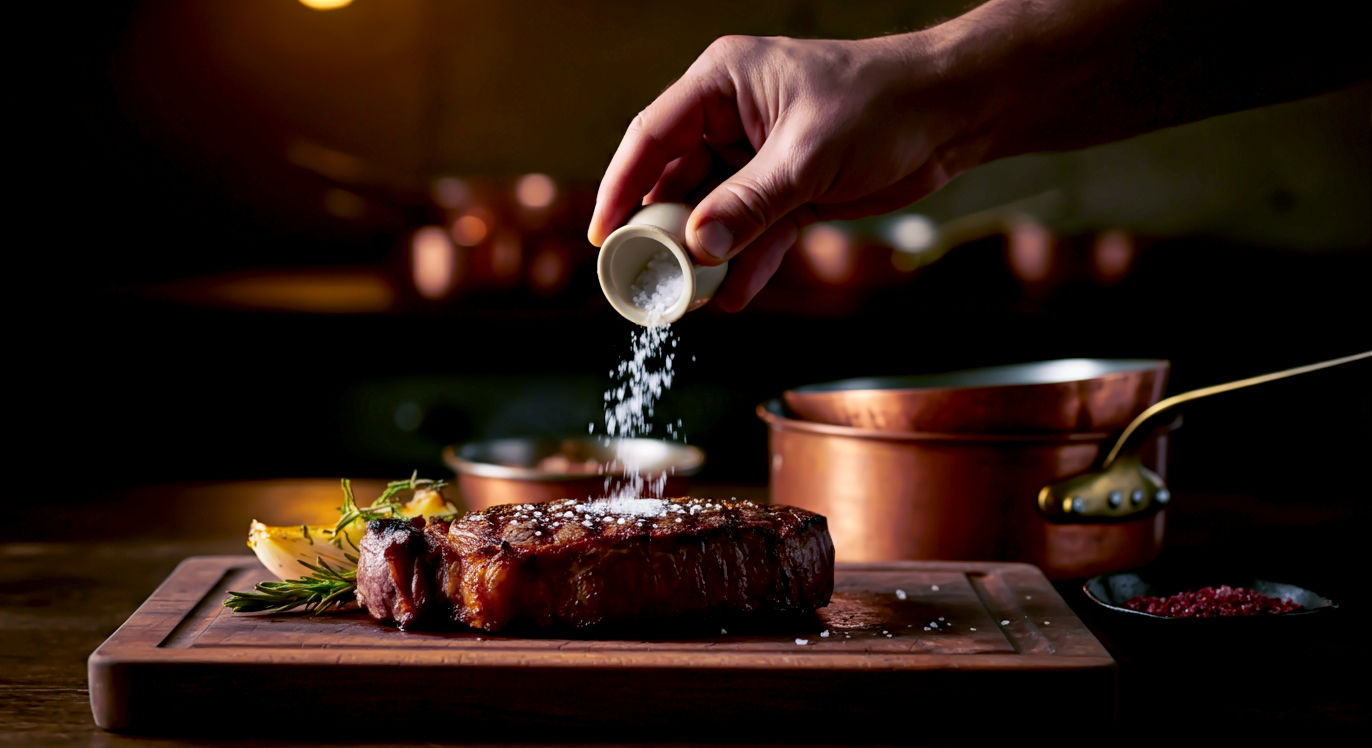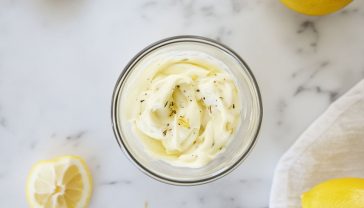Kosher Salt: The Chef’s Secret Weapon and Why Your Kitchen Needs It
From Jewish tradition to every top chef’s kitchen, learn why coarse kosher salt is the one ingredient that will change the way you cook for good.

This post may contain affiliate links. If you make a purchase through these links, we may earn a commission at no additional cost to you.
Ever watch a chef on the telly? You’ll see them whisking, chopping, and searing with incredible speed. But watch closely when they season. They rarely reach for a standard salt shaker. Instead, they’ll dip their fingers into a small pot or box and, with a flourish, shower a cascade of coarse, white crystals over a steak or a pan of sizzling veg. That, right there, is almost always kosher salt. And for a long time, it was one of the professional kitchen’s best-kept secrets.
But the secret’s out. From Michelin-starred restaurants in London to trendy cafes in Manchester and home kitchens in the Scottish Highlands, this coarse cousin of table salt has become a must-have ingredient. You might be wondering, what’s the big deal? Isn’t salt just… salt?
Well, yes and no. Getting your head around kosher salt is one of those small changes that makes a massive difference to your cooking. It’s not about fancy, expensive ingredients or complicated techniques. It’s about control, texture, and flavour. It’s about understanding why this particular salt gives you better results, whether you’re seasoning a Sunday roast, salting a pot of pasta water, or even baking a batch of chocolate chip biscuits.
This guide is your complete introduction. We’ll explore what kosher salt actually is (and what it isn’t), why it has that name, and how it stacks up against the other salts in your cupboard. We’ll dive into its history, its science, and most importantly, how to use it to make your food taste better. So, grab a cuppa, and let’s talk about the humble crystal that will change the way you cook for good.
What on Earth Is Kosher Salt, Anyway?
Before we get into the nitty-gritty, let’s clear up the biggest misconception. Kosher salt is not necessarily “kosher” in the way many people think. While most kosher salt is indeed certified as kosher (meaning it’s prepared in accordance with Jewish dietary laws), the name doesn’t come from a rabbi blessing the salt.
The name comes from its original, specific purpose: the process of kashering meat.
It’s All About the Koshering Process
In Jewish tradition, for meat to be considered kosher, it must be drained of blood. To do this, meat is covered in salt, which draws out the moisture and blood through osmosis.
Now, you can’t just use any old salt for this. If you used fine table salt, it would dissolve too quickly into the meat, essentially curing it and making it far too salty. You need a salt with large, coarse grains that will cling to the surface of the meat, do the job of drawing out the blood, and then be easily rinsed away without over-salting.
The salt that was perfect for this job was coarse-grained salt. And so, it became known as “koshering salt,” which was eventually shortened to just kosher salt.
It’s a tool designed for a specific job, and it just so happens that the properties that make it brilliant for kashering also make it brilliant for cooking.
The Science Bit: It’s All in the Shape
At a chemical level, all salt is the same stuff: sodium chloride (NaCl). Whether it’s cheap table salt, fancy pink Himalayan salt, or flaky sea salt, it’s all made of the same two elements. The difference between them comes down to three things:
- How they’re harvested.
- What, if any, trace minerals they contain.
- The shape and size of their crystals.
For kosher salt, that last point is the most important one. Unlike the tiny, dense cubes of table salt, kosher salt has a much larger, more irregular crystal structure. There are two main ways it’s made, which produce slightly different shapes.
- Compacted Flake Salt: This is made by taking regular salt crystals and feeding them through high-pressure rollers, which flattens them into large, thin, flaky shapes. This process creates a salt with lots of surface area but very little density. Think of it like a snowflake—light, airy, and delicate. The most famous brand of this type is the American Diamond Crystal.
- Evaporated Salt: This type is made by evaporating brine in a vacuum. This encourages the salt to form hollow, pyramid-like crystals. These are crunchier and more robust than the flaked kind. This is how brands like Morton (another American giant) make their kosher salt.
So, why does this shape matter so much? Because it completely changes how the salt feels in your hand, how it sticks to food, and how it dissolves. It’s less like a tiny, hard pebble and more like a crunchy, flaky crystal.
A Pinch of History: The Journey from Tradition to Trend
Salt has been a cornerstone of human civilisation for thousands of years. It was used as currency by the Romans (the word “salary” comes from sal, the Latin for salt), it preserved food through long winters, and it has started wars. But the story of kosher salt as a culinary staple is much more recent.
For centuries, it remained a specialist ingredient, primarily used within Jewish communities for its intended purpose of kashering. In the wider world, fine-grained, free-flowing table salt was king. The invention of anti-caking agents in the early 20th century was a game-changer, making salt easy to pour from a shaker and cementing its place on every dinner table.
So how did this coarse, flaky upstart from a niche tradition end up in every top chef’s arsenal?
The shift began in the culinary schools of America in the mid-20th century. European-trained chefs brought with them a preference for seasoning by hand, using coarse salt for better control. As they taught the next generation of chefs, they passed on this technique. Kosher salt, which was readily available and cheap in the US, was the perfect tool for the job.
Then came the rise of the TV chef in the 1990s and 2000s. Suddenly, millions of home cooks were watching their culinary heroes bypass the shaker and grab a healthy three-fingered pinch of coarse salt. They explained why they were using it: you could feel it, you could see it, and it tasted cleaner. It looked professional. It looked cool.
Crossing the Pond to Britain
Here in the UK, the revolution took a little longer. For a long time, our salt landscape was dominated by two things: standard table salt (often Saxa) and our beloved flaky sea salt, Maldon. Maldon salt, harvested from the estuaries of Essex since 1882, was our go-to for a bit of crunchy, finishing flair.
But as British food culture became more global and ambitious, things started to change. Chefs like Yotam Ottolenghi and Nigella Lawson, who champion bold flavours and accessible techniques, began to feature kosher salt in their recipes. Cookbooks and food blogs started specifying it. Delis and larger supermarkets began to stock it.
British home cooks, always keen to learn and improve, started to catch on. They realised that kosher salt wasn’t trying to replace their cherished Maldon. Instead, it filled a gap they didn’t even know they had: the need for a reliable, all-purpose seasoning salt for use during the cooking process itself. It was the workhorse, while Maldon remained the show pony.
Today, kosher salt is no longer a niche, imported oddity. It’s a staple.
The Great British Salt Debate: Kosher vs. The Rest
Choosing a salt can feel surprisingly complicated these days. The supermarket aisle is full of options, from basic table salt to fancy pink, black, and grey varieties. Let’s break down how kosher salt compares to its main rivals.
Kosher Salt vs. Table Salt
This is the most important comparison, because for most day-to-day cooking, kosher salt is a direct and superior replacement for table salt.
- Texture and ‘Pinch-ability’: This is the number one reason chefs love it. The large, flaky crystals are easy to pick up. You can feel exactly how much salt you’re adding, giving you far more control than a random shake from a dispenser. Table salt is too fine to get a good feel for it.
- Adhesion and Coverage: The irregular shape of kosher salt crystals helps them stick better to the surface of food. When you season a chicken or a steak before cooking, the flakes will adhere evenly, creating a perfect crust. Fine table salt tends to bounce off or clump together.
- Lack of Additives and ‘Cleaner’ Taste: This is a big one. To stop it from clumping in damp British weather, table salt contains anti-caking agents like sodium ferrocyanide or silicon dioxide. Many brands are also iodised—meaning iodine has been added to prevent iodine deficiency, a public health measure that began decades ago. While these additives are perfectly safe, some people can detect a faint metallic or chemical bitterness from them. Kosher salt is typically just pure sodium chloride. Its taste is cleaner, more straightforwardly salty.
- Density and Saltiness (The Volume vs. Weight Trap): This is absolutely crucial, especially for baking. Because kosher salt crystals are large and hollow or flaky, they take up more space for their weight. A teaspoon of kosher salt is less salty than a teaspoon of dense table salt.
A Crucial Rule of Thumb: If a recipe calls for 1 teaspoon of table salt, you will need roughly 1.5 to 2 teaspoons of kosher salt to achieve the same level of saltiness (the exact amount depends on the brand). This is why so many modern recipes, particularly for baking, specify salt by weight (in grams). It’s the only way to be truly accurate.
Kosher Salt vs. Flaky Sea Salt (e.g., Maldon)
This isn’t really a competition; it’s a partnership. Many British kitchens will have both, and for good reason. They do different jobs.
- Source and Flavour: Kosher salt is usually mined from underground deposits, whereas sea salt is made from evaporated seawater. This means sea salts like Maldon can contain trace minerals from the ocean, which can add a subtle complexity to their flavour—a certain briny quality.
- Texture and Use: While both are coarse, they are different. Kosher salt’s texture is consistently flaky or granular, and it dissolves relatively quickly, making it the perfect seasoning salt. You use it during cooking to build layers of flavour from within. Maldon’s famous pyramid crystals are incredibly delicate and crunchy. They are the perfect finishing salt. You sprinkle them on top of a dish just before serving to add a pop of clean, salty crunch and visual appeal. Think of it on top of a chocolate torte, a grilled piece of fish, or a simple plate of sliced tomatoes.
- Cost: Kosher salt is an affordable, everyday workhorse. A big box will cost you a few quid and last for ages. Flaky sea salt is more of a luxury item, to be used more sparingly.
The Verdict: You need both. Use kosher salt for the heavy lifting of seasoning during cooking, and use your fancy sea salt for that final, crunchy flourish.
Kosher Salt vs. Himalayan Pink Salt and Other ‘Posh’ Salts
What about all those other colourful salts you see in fancy jars? Himalayan pink, Hawaiian black lava salt, Persian blue salt… they look lovely, but are they worth the money?
For the most part, their unique properties are purely cosmetic. The pink in Himalayan salt comes from traces of iron oxide (rust, basically). The black in lava salt comes from activated charcoal. While proponents claim they contain dozens of beneficial trace minerals, the amounts are so minuscule as to have no significant impact on your health or the flavour of your food.
Their crystal structures are often very hard and dense, meaning they don’t dissolve well. This makes them poor choices for general seasoning. Like flaky sea salt, they are best thought of as finishing salts, used for their colour and crunchy texture.
Kosher salt remains the undisputed champion for value, versatility, and performance in the kitchen.
In the Kitchen: A Practical Guide for the British Cook
Right, you’re convinced. You’ve bought a box of kosher salt. Now what? How do you actually use it to make your cooking better? The key is to think of it not just as an ingredient, but as a technique.
The Power of Seasoning from a Height
This is the first trick to learn. Put your kosher salt in a small bowl or a salt pig (a small, lidded pot). When you season, take a pinch and sprinkle it from about 12 inches (30cm) above the food.
It might feel a bit dramatic, like you’re Salt Bae in the making, but there’s a real purpose to it. It allows the salt crystals to disperse evenly over the entire surface of the food, rather than landing in one concentrated clump. This guarantees a uniformly seasoned dish. It’s impossible to do this with a shaker.
Key Uses for Your New Favourite Ingredient
- Seasoning Meat, Poultry, and Fish: This is where kosher salt truly shines. Its coarse flakes cling perfectly to the surface. Pat your joint of beef, chicken, or fillet of fish dry with a paper towel, rub it with a little oil, and then season it generously with kosher salt from a height. This will help to form a delicious, crispy crust when you roast, fry, or grill it.
- Salting Water for Pasta and Vegetables: When you’re boiling pasta, potatoes, or green veg, you want the water to be “as salty as the sea.” Because kosher salt dissolves quickly and has a clean taste, it’s perfect for this. Its lower density also means you’re less likely to accidentally over-salt the water.
- Making Brines and Cures: A brine is simply a solution of salt and water, often with sugar and spices added. Soaking meat (especially lean cuts like chicken breast or pork chops) in a brine before cooking is a brilliant way to make it more juicy and flavourful. Kosher salt is the ideal choice for brines because it dissolves easily and, thanks to its purity, won’t make the liquid cloudy. It’s also the star ingredient for curing your own bacon or gravadlax at home.
- General Seasoning in Sauces, Soups, and Stews: When you’re building flavour in a bolognese, a casserole, or a soup, add a pinch of kosher salt at each stage. Add some when you’re sweating your onions and carrots, another pinch when you add your tomatoes, and so on. This builds a deeper, more complex flavour profile than just adding a load of salt at the very end.
- Baking (with Caution!): Salt is a vital ingredient in baking. It enhances the flavour of everything, balances sweetness, and helps to control yeast. You can absolutely use kosher salt in baking, but you must be mindful of the volume-to-weight issue we discussed earlier. If your recipe is from a British or European source that gives measurements in grams, brilliant! Just weigh your kosher salt and you’re good to go. If it’s an American recipe using cups and teaspoons, you will need to adjust. As a general rule, use about 1.5 times the volume of kosher salt if the recipe calls for table salt.
- Rimming Cocktail Glasses: The coarse texture of kosher salt is perfect for creating that classic salty rim on a Margarita or a Salty Dog. It looks great and provides a pleasant, crunchy texture.
Common Pitfalls to Avoid
- Forgetting the Conversion: This is the biggest one. If you substitute kosher salt 1:1 for table salt in a recipe that uses volume (teaspoons), your food will be under-seasoned.
- Not All Brands Are the Same: The two big American brands, Diamond Crystal and Morton, have very different densities. Diamond Crystal is much lighter and flakier. One teaspoon of Morton’s is almost as salty as one teaspoon of table salt, whereas you’d need nearly two teaspoons of Diamond Crystal. While these brands are less common in the UK, it’s a good reminder that kosher salts can vary. Get to know the brand you’ve bought and how salty it tastes.
- Mistaking It for a Finishing Salt: Can you sprinkle it on your food at the end? Yes, of course. But it won’t give you that signature, delicate crunch of a true flaky sea salt like Maldon. Use the right tool for the job.
The Final Word: Your New Kitchen Workhorse
In a world of culinary fads and expensive gadgets, it’s refreshing to find that one of the most significant improvements you can make to your cooking comes in a simple cardboard box that costs just a few pounds.
Switching to kosher salt isn’t about being a food snob. It’s about being a better, more intuitive cook. It’s about engaging with your food on a more tactile level, moving from blindly shaking to consciously seasoning. It gives you control, enhances texture, and provides a cleaner, purer flavour.
It won’t replace the special place that flaky sea salt holds in the heart of British cooks—that final, celebratory crunch is a joy of its own. But for every task that comes before that final flourish, from salting your pasta water to seasoning your Sunday roast, kosher salt is the reliable, versatile, and superior choice.
Give it a go. Put some in a small bowl by your hob, and for one week, use it for all your cooking. Feel it in your fingers, watch how it falls, and taste the difference. It might just be the best culinary decision you make all year.
Further Reading & Resources
For those looking to dive even deeper into food science and culinary techniques, these resources are highly recommended:
- Serious Eats: An outstanding resource for understanding the science behind cooking, with detailed articles on topics like salt, meat, and more.
- BBC Good Food: A trusted source for recipes and cooking tips tailored to a British audience.
- The Food Lab by J. Kenji López-Alt: While a book, its influence on modern home cooking is immense, and it contains brilliant explanations of fundamental concepts like seasoning.
- Maldon Salt: Explore the website of Britain’s most famous sea salt producer to understand more about the heritage of flaky finishing salts.






